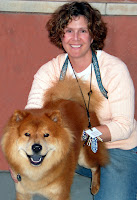Dogs in Drag

I used to teach a lot of puppy classes, and a big ticket item in the curriculum was handling and gentling. We’d do mock veterinary exams in class, grooming practice, collar grabs and simulations of the typical body-touch scenarios a dog might encounter in day to day life. If a puppy came up spooky or recalcitrant, most commonly about one of the usual suspects like feet, head or rear quarters, we’d flag it and assign extra exercises for the guardian to do at home. And everyone would get standard prevention exercise homework. The goal was for the puppy to welcome and enjoy having his body manipulated, not just tolerate it. All well and good.
The fly in the ointment was compliance. The people whose puppies had no identified issues usually didn’t practice at all and, alarmingly, the guardians of the puppies with red flags often didn’t find the time or inclination to practice either. I’d pitch ounce of prevention, give user-friendly homework sheets and progress charts, and tell cautionary tales of if-only dogs with refractory adult body handling problems. But I made minimal impact. The homework was, well, work. Enter doggie dress-up.

The impetus for doggie dress-up was the “dogs going over little jumps” effect. To add spice to coming when called exercises in adult obedience classes, I sometimes had the guardians put their dogs on stays on the other side of a low jump and call the dog over the jump. Now if you’ve watched obedience classes much, you’ll see that it’s all over the map when people are supposed to be practicing. Some people diligently repeat the exercise they’re supposed to be doing, some stand awkward and slack-jawed waiting for more guidance and some do a few repetitions, apparently consider their dog “trained” and so retire to their seat to make a phone call. But not when there were little jumps involved. They’d all practice over and over and over. Family members would *fight* with each other to train the dog. We instructors would marvel at the sudden extreme interest in short-distance recall exercises. Dogs going over little jumps. They were crazy for it.
And so to spruce up body-handling homework, I brought in a bunch of dog costumes to one of my puppy classes one week and had them choose one to take home and try out. I then proceeded to the next class activity. I rang my little bell and cleared my throat to gain their attention for some Very Important demonstration or other. No dice. Too busy transforming their puppies into little Spidermen, fairy princesses and biker chicks. I surfed the wave. Who, by next week, could come up with the most fabulous get-up using this or other costume as springboard and, importantly, modeled by a puppy who loves his get-up. It would take lots and lots of practice and lots and lots of plying with treats but anyone up for this challenge had the chance of winning a three-dollar prize.

The following week it was like a Pride Parade. There were family members attending who hadn’t yet made an appearance at class, people pushing and pulling puppies into neon pink varsity sweaters, aviator goggles and animal print booties, then delivering roast chicken and three year-old parmesan to wagging puppies while flashbulbs popped. And this was in the hallway before class even started.
I think I understand well-meaning people who get frowny at the indignity of dogs in little costumes and tut-tut at whatever insidious pathology they speculate drives us dog parents to do it. But I think they’re backing the wrong horse if animal welfare is their concern. Not only do little costumes prompt dog body handling, they prompt brain baths of bonding chemicals in dog guardians. Numerous studies have been performed on risk factors for relinquishment of pets to animal shelters. A common finding is that dogs who are perceived by their owners to be attractive – the cuteness factor - are at reduced risk for relinquishment (e.g. New, Salman, Scarlett, Kass, King & Hutchison, JAAWS, 2002). Note that this is not a reduction in relinquishment risk for dogs that are by any objective measure “attractive.” It’s eye of the beholder, and beholder picks the get-up. People dig putting their dogs into little costumes. Dogs usually like the attention, always love the treats and get used to having their bodies handled, putting them at lower risk for stress and aggression.
 It took me probably five ounces of smoked salmon to get Buffy to love her tiara, poodle skirt and pillbox hat and several jars of baby food to get her wagging when I cracked out the “Doggles,” but aside from the fabulousness of it all, I felt fancy indeed when my veterinarian remarked that she had never seen a chow so readily accept having her head restrained. And I admit a secret urge to issue cute little argyle turtlenecks to solemn-looking owners of possibly at-risk dogs wearing plain black nylon collars. Life’s just too short.
It took me probably five ounces of smoked salmon to get Buffy to love her tiara, poodle skirt and pillbox hat and several jars of baby food to get her wagging when I cracked out the “Doggles,” but aside from the fabulousness of it all, I felt fancy indeed when my veterinarian remarked that she had never seen a chow so readily accept having her head restrained. And I admit a secret urge to issue cute little argyle turtlenecks to solemn-looking owners of possibly at-risk dogs wearing plain black nylon collars. Life’s just too short.

